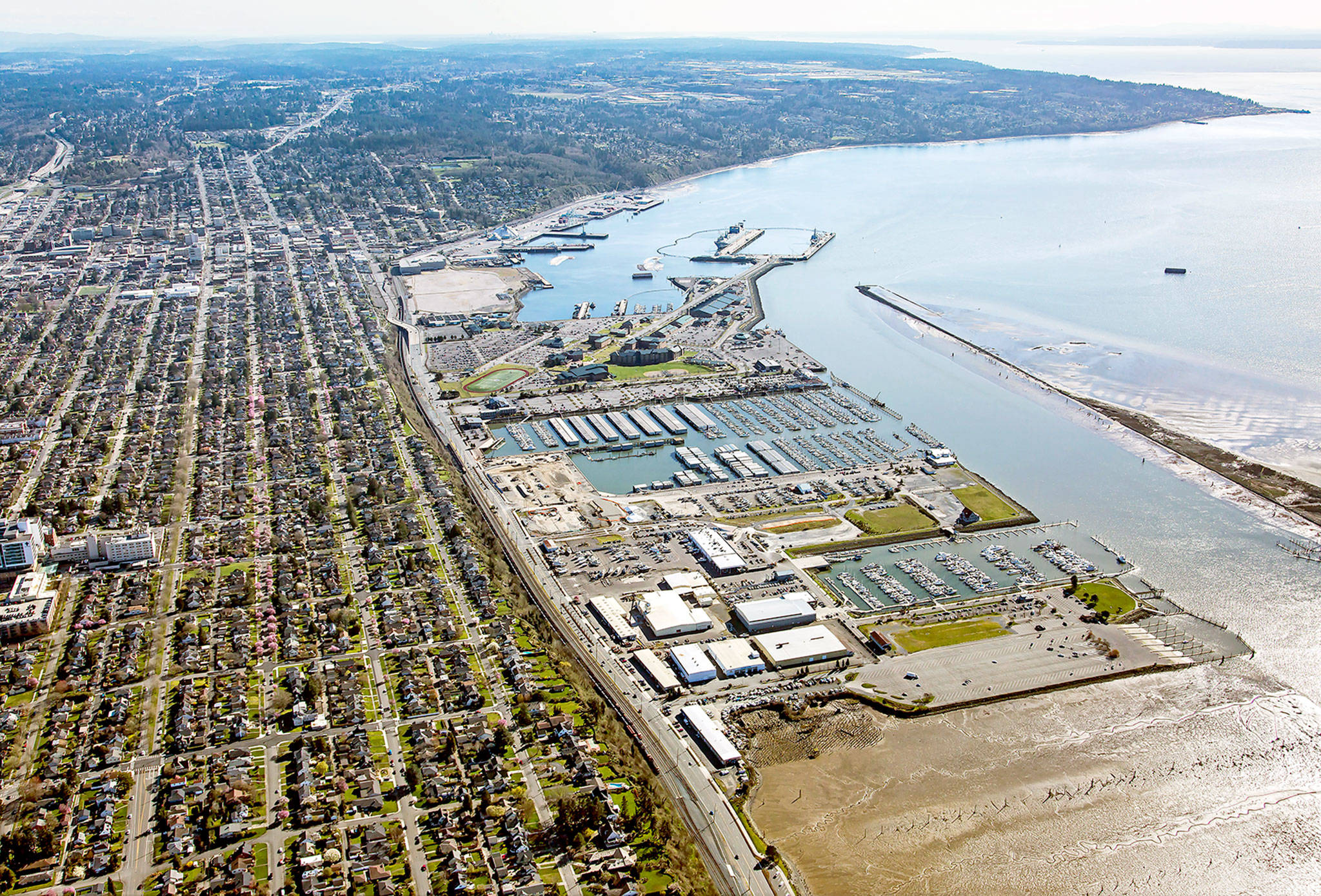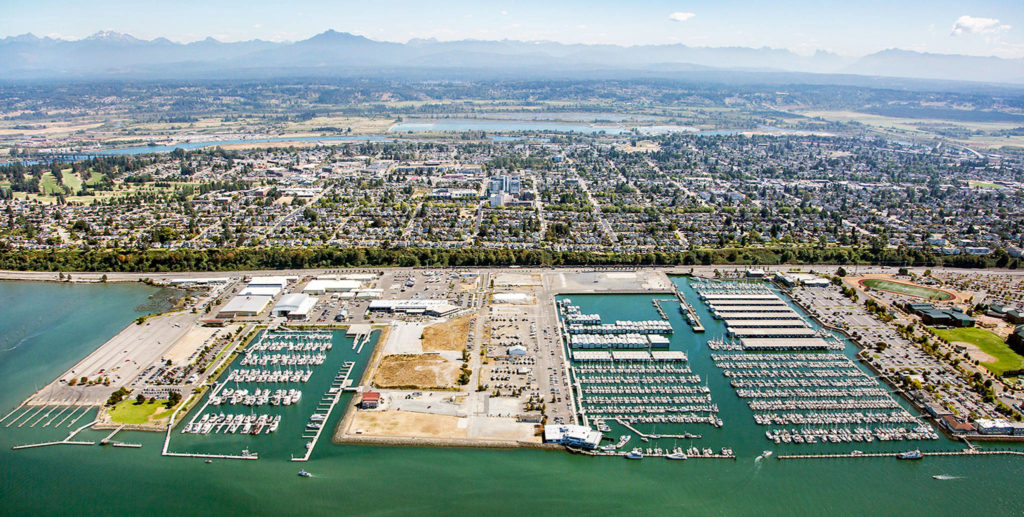This is one of a collection of stories marking the Port of Everett’s 100th anniversary in July.
The Port of Everett is a public entity created by voters on July 13, 1918. It was a lopsided election, with 1,789 votes in favor of its creation and only 57 opposed. Here’s a rundown of what the Port of Everett does, how it is governed, where the money comes from — and where it goes.
The basics
The mission of the Port of Everett is to foster economic development and job creation and to provide public access to the waterfront through parks and recreational activities.
It operates like a business. The seaport, marina, Riverside Business Park and other operations must support themselves. Taxes levied by the port in a surrounding taxing district are used only for environmental cleanup and capital projects.
The port has three commissioners who are elected to six-year terms. Each is paid $635 per month and $114 per day for every port meeting they attend — up to a maximum of 120 meetings.
The commissioners are responsible for setting policy. They hire a CEO to carry out those policies. Lisa Lefeber is the port’s acting chief executive. The port’s CEO, Les Reardanz, a captain in the Naval Reserve, was deployed to Afghanistan in February. He is scheduled to serve through October.
The seaport
The Port of Everett is the third-largest container port in Washington, after the ports of Seattle and Tacoma.
Everett’s niche is aerospace components and industrial and agricultural equipment. The port typically does not handle consumer products.
Major imports incloude aerospace parts, energy supplies, heavy machinery, cement, and containers bearing agricultural and industrial components.
Major exports are energy supplies, heavy machinery, forest products, and equipment and supplies for gold mining in Russia.
The Port of Everett has two main cargo sites — the South Terminal area on the Everett waterfront, where the biggest ships call, and the Mount Baker Terminal in Mukilteo.
The Mount Baker terminal is not a deep-water port and cannot accommodate big ships. It’s designed to handle barges of up to 300 feet. Boeing, one of the port’s major clients, operates on a just-in-time delivery basis. Containers of aerospace components are offloaded and stored at the main seaport area in Everett until Boeing calls for them. When that occurs, they’re loaded onto a barge and ferried from Port Gardner to the Mount Baker Terminal in Mukilteo, where they can be loaded onto rail cars that carry the containers to the Everett Boeing assembly plant at Paine Field.
The seaport has several cranes to hoist containers and other cargo. The tall, light-blue cranes can each lift up to 40 tons, the equivalent of seven adult elephants. Two additional cranes can support up to 110 tons (18 elephants) and 150 tons (25 elephants), respectively.
The port handles all ocean-going oversized parts for the Boeing assembly lines of the 747, 767, 777 and KC-46 tanker. Parts for the 787 arrive at the Boeing plant on Dreamlifter airplanes — converted 747s — but if something can’t be flown in, the port serves as a back-up facility.
Eight shipping lines call on the Port of Everett: Westwood Shipping Lines; Far Eastern Shipping Co.; Sakhalin Shipping Co.; Eastern Car Liner; Eukor Car Carriers Inc.; Hyundai Glovis Co.; Austral Asia Line; and Swire Shipping Austral Asia Line.
The marina
The Port of Everett marina is the largest public marina on the West Coast, with 2,300 slips. Ten percent of the vessels there can be live-aboards.
Taxes and budget
The Port of Everett says cargo, marina and tenant activity created $373.2 million in state and local tax revenue in 2017. The state of Washington received about $227.7 million of that, with local governments receiving the balance. The port also levies its own tax on property owners in a taxing district. The boundaries encompass most of Everett and parts of Mukilteo and unincorporated Snohomish County. Lines were drawn a century ago and have been expanded only once — to include Hat Island. In 2011, district lines were shifted so that each now touches a waterfront community.
The port expects to collect about $4.9 million in taxes in 2018. This year’s tax rate is about 27 cents per $1,000 in assessed value. Tax revenue can be used only for environmental cleanup or capital projects.
The 2018 port budget is approximately $86 million, which includes $26 million in operating expenses; $44 million in new capital investment; and $10 million in capital investment carrying forward from last year. The port also expects to pay $6.2 million in principal and interest on long-term debt.
This year the port’s budget proposes work on 56 of the capital projects. The two largest are the real estate development called Fisherman’s Harbor and modernization of the seaport’s South Terminal Wharf to enable it to accommodate larger containers and heavier cargo, including larger aerospace parts for the Boeing 777X.
The port employs about 100 people to operate the seaport and marina and the development of nearly 900 acres of waterfront property. That number excludes private workers such as stevedores, longshore workers and tugboat operators.
Just for fun
• The Port of Everett’s seaport supports a gold mining operation in Russia. Equipment and supplies are picked up from the container port in the summer and transported to an Arctic Russian port. The supplies are stored there until waterways freeze, when the cargo can be trucked to the mining operation. (Think the reality television series, “Ice Road Truckers.”)
• The historic Weyerhaeuser Building weighs 350 tons and has been moved three times. It’s now located at Boxcar Park near Waterfront Place. Built in 1923, the heaviest portion of the 80-foot by 65-foot structure is a 150-ton steel safe the size of an elevator, located in the middle of the building. The port plans to use the building as a marine clubhouse with an outdoor performance venue. The goal is to re-open the building by 2020.
• The wooden vessel on display at the southwest corner of Craftsman Way and 10th Street is the good ship Equator, built in 1888 as a two-masted schooner. It once carried writer Robert Louis Stevenson on voyages to the South Pacific. The Equator, which received an engine in 1893 and was completely renovated in 1923 and served until the mid-1950s as a tug. The ship was left on Jetty Island in 1956 as part of a breakwater with other discarded vessels. The port owns the property and the shed in which it resides. A private effort to restore the ship has languished.
Source: Port of Everett
Talk to us
> Give us your news tips.
> Send us a letter to the editor.
> More Herald contact information.



























